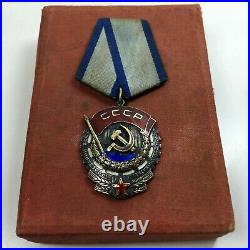
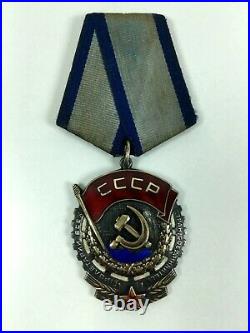
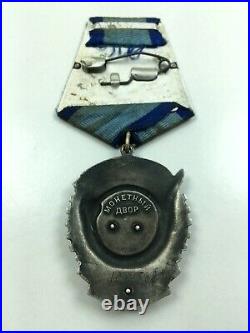
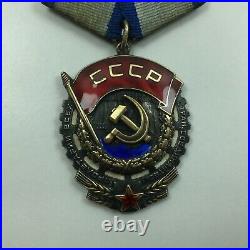
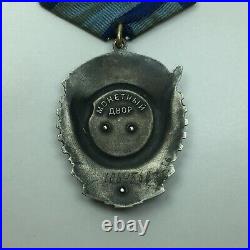


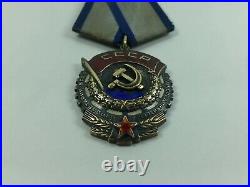
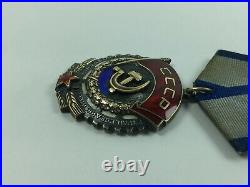
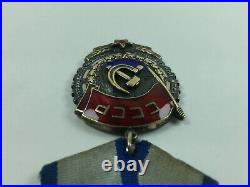
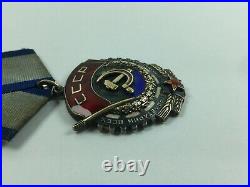
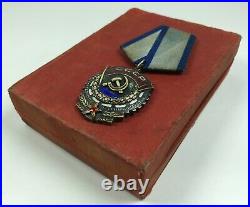

Original silver and gilt order of the red banner of Labor state award of the Union of Soviet Socialist Republics. The total weight of the order is 38 g. The height of the order is 44 mm. The order of the sample of 1943, repeats the sample of 1936, but is adapted for wearing on a pad with a ribbon. The badge of the order of the red banner of Labor has an oval shape. The edges of the sign are made in the form of a gear wheel, the upper part of which is covered with a banner of ruby-red enamel. In the center of the obverse of the order is a gilded image of a hammer and sickle against the background of a hydroelectric power station and a railway bridge. Below the image is framed by a Golden oak wreath in the form of a semicircle. On the cogwheel framing the order the inscription: Proletarians of all countries, unite! ” On the banner banner-the inscription in gold letters “USSR. In the lower part of the order along the gear wheel to the right and left diverge wheat ears, intercepted in the middle by a wide ribbon, which shows a five-pointed star, covered with red enamel. The order is made of silver. The size of the order: height-44 mm, width-37 mm. In the upper part of the order sign there is an ear, which it is connected with a ring with a pentagonal pad, covered with the order’s ribbon. On the reverse side of the pad-a device for attaching the order to clothing. Ribbon of the order of the red banner of Labor silk moire dark blue with two longitudinal blue stripes on the edges. The width of the blue stripes is 3.5 mm. The total width of the tape is 24 mm. Established by the Decree of the CEC and SNK of the USSR on September 7, 1928. Approved by the Resolution of the CEC of the USSR, adopted at the 4th session of the 4th convocation on December 15, 1928. The Statute of the order was amended by the Decree of the CEC and SNK of the USSR of may 7, 1936 and by Decrees of the Presidium of the Supreme Soviet of the USSR of June 19, 1943 and December 16, 1947. The decree of the Presidium of the Supreme Soviet of the USSR of March 28, 1980 approved the Statute of the order in a new version. Statute of the order. This order was established for awarding great labor services to the Soviet state and society in the field of production, science, culture, literature, art, public education, health, in the state, public and other spheres of labor activity. The order of the red banner of Labor is awarded to. Citizens of the USSR. Enterprises, associations, institutions, organizations, Federal and Autonomous republics, territories, regions, Autonomous regions, Autonomous districts, districts, cities and other localities. The order of the red banner of Labor can also be awarded to persons who are not citizens of the USSR, as well as enterprises, institutions, organizations and localities of foreign countries. Award of the Order of the red banner of Labor is made. For great achievements in the development of industry, agriculture, transport, construction and other sectors of the national economy, in improving the efficiency of public production, for the highest indicators of labor productivity growth, improving product quality, development and implementation of more advanced technological processes. For stable and high results in the implementation and overfulfillment of planned assignments and socialist obligations undertaken. For major achievements in increasing crop yields and productivity of public livestock, increasing the production and sale of agricultural products to the state. For great achievements in the development of science and technology, the introduction of their latest achievements in the national economy, for inventions and innovation proposals of great technical and economic significance. For great services in strengthening the country’s defense capability. For particularly fruitful work in the field of Soviet culture, literature and art. For great services in training and Communist education of the younger generation, training of highly qualified personnel in the field of health care, development of trade, public catering, housing and communal services, consumer services, for special achievements in the development of physical culture and sports. For important services in the field of state and public activity, in strengthening the socialist law and order. For great services in the development of economic, scientific, technical and cultural cooperation between the USSR and other States. The order of the red banner of Labor is worn on the left side of the chest and, if there are other orders, is placed after the order of the red banner. Description of the order. The order of the red banner of Labor is a sign depicting an unfurled Red Banner covered with ruby-red enamel with the inscription USSR, below which is placed on the circle the image of a gear wheel with the inscription on the rim Proletarians of all countries, unite! . The rim of the gear wheel and the inscription on it are oxidized. The inscription on the banner, the shaft and rims of the banner are gilded. In the inner part of the gear wheel is placed a gilded wreath of oak leaves, intertwined at the bottom with two narrow ribbons. In the center of the wreath are depicted a hydroelectric dam, a railway track laid over a bridge combined with a dam, and a river. On their background, there are gold-plated sickle and hammer overlays. All images inside the wreath are oxidized, except for the image of the river, which is made of blue enamel. The background between the rim of the gear wheel and the wreath is covered with white enamel. At the bottom of the order is a wreath of two rows of wheat ears. The wreath and the lower part of the gear wheel are intertwined with a gilded ribbon, on which there is a five-pointed star covered with ruby-red enamel with a gilded outline. The order of the red banner of Labor is made of silver. Silver content in the order – 33.218±0.385 g (as of September 18, 1975). The total weight of the order is 36.5±1.75 g. The height of the order is 44 mm, width-37 mm. The order is connected by means of an ear and a ring to a pentagonal block covered with a silk moire ribbon of dark blue color with two longitudinal blue stripes along the edges. The width of the tape is 24 mm, the width of the strips is 3.5 mm. History of the order. The order of the red banner of Labor is the second Soviet order in time of establishment (after the order of the red banner). The drawing order of the red banner of Labour of the sample of 1928 was the artist Kupriyanov, V. And the drawing of the order of the model 1935 was the medalist of the Leningrad Mint Golenetskii V. Prior To the establishment of the order of the red banner of the USSR, the VIII all-Russian Congress of Soviets on December 28, 1920 was established the order of Red Labor Banner of the RSFSR, and later these orders were established in other Soviet republics. The first collectives awarded the order of the red banner of Labor of the RSFSR were Tula weapons and cartridge factories, Okhtensky and shostkin capsule factories, awarded on April 25, 1921 for the implementation of the program for the production of rifles and cartridges during the threat of capture of Tula by Denikin’s white guard troops. Nizhny Novgorod radio laboratory was twice awarded the order of the red banner of Labor of the RSFSR. The first award took place on September 19, 1922, and the second in 1928. In addition to the Nizhny Novgorod radio laboratory, no other team or person in the entire history of this distinction was awarded two orders of the red banner of Labor of the RSFSR. Industrial enterprises were awarded the order of the red banner of Labor in other republics as well. So in 1923, the order of the red banner of Labor of the Ukrainian SSR was awarded to the Kiev plant Arsenal. It is interesting to note that military units also received this purely peaceful order. For example, the 2nd Amur rifle division, the 220th Slavic regiment of the 74th rifle division, and the 19th air Squadron far Eastern Ultimatumwere awarded the order of the red banner of Labor of the RSFSR for their heroism in the fight against flooding. The first private person who received the order of the red banner of the RSFSR, was a farmer, Bykhov district, Gomel province of Menchukov Nikita, is awarded by Decree of the VTSIK of the RSFSR of July 28, 1921, for the selfless protection against Chigirinsky ice bridge. With the establishment in 1928 of the order of the red banner of the USSR, awarded the order the Labour red banner of the RSFSR and similar orders of other Soviet republics was terminated, but for individuals previously awarded these orders, preserved the rights and benefits provided for in the statutes of those orders. The first recipients of the order of the red banner of Labor of the USSR were mechanics of the Air Force Fedotov V. For their active participation in the rescue expedition to find the airship Italy, which had an accident near the North Pole. The order of the red banner of Labor of the USSR # 1 was awarded to the staff of the Leningrad plant “Krasny Putilovets” (later Kirov plant) in connection with the 125th anniversary of its Foundation. Before the beginning of the great Patriotic war in the USSR, more than 8 thousand awards of the order of the red banner of Labor of the USSR were made. During the great Patriotic war, the order of the red banner of Labor of the USSR was awarded to about 21,500 home front workers. Since awards could be repeated for new labor achievements, there are several recipients of the order of the red banner of Labor. The maximum number of awards of this order known to us is six. Nikolay Smelyakov was awarded six orders of the red banner of labor. During the great Patriotic war, he worked as a Deputy chief Metallurgist, head of the shop and chief Metallurgist of the Krasnoe Sormovo plant in Gorky. After the war, Nikolai Nikolaevich worked in many responsible positions: Director of the Krasnoe Sormovo plant, Chairman of the Gorky state farm, Minister of mechanical engineering of the USSR and for more than a quarter of a century – Deputy Minister of foreign trade of the USSR. Five orders were awarded to the people’s artist of the USSR, Uzbek dancer Tamara Khanum, historian academician Ilichev L. Among the recipients of four orders-the world-famous ballerina Galina Ulanova, actress Natalia Uzhviy, composers Revutsky and Balanchivadze and others. Colonel-General Boris Tikhonovich Shumilin became a four-time recipient of the order of the red banner of Labor. During the war, he was a member of a partisan unit. After the war, he graduated from the Higher Party School, worked in various leadership positions of the party bodies of Belarus. For some time Shumilin headed the Ministry of Public Order Protection of Belarus, and since 1967 was the Deputy Minister of internal Affairs of the USSR. Four orders of the red banner of Labor were awarded to the Hero of Socialist Labor, people’s artist of the USSR, Professor of the Tallinn Conservatory Eugen Kapp. Foreign citizens were also awarded the order of the red banner of Labor. For example, by decree of the Presidium of the Supreme Soviet of the USSR on February 9, 1945, this award was awarded to the second Secretary of the British Embassy in the USSR, Bierce Arthur Herbert, for “successful work in negotiations between the leaders of the Soviet Union and great Britain during the Tehran Conference and at their subsequent meetings”. The order of the red banner of Labor is the most common award for enterprises, organizations and institutions. After the great Patriotic war, the awarding of enterprises became widespread. For example, the Moscow 2nd watch factory (1966); the Moscow mining Institute (1969); the Moscow operetta theater (1977); the Moscow automobile Institute (1980); the Leningrad Association Svetlana (1942 and 1966); the Lenfilm film Studio (1976); the Kiev medical Institute (1944); the Kiev Institute of civil aviation engineers (1966) and many other enterprises and organizations. Among the periodicals awarded this order are the Newspapers Izvestia (1949), Trud (1951), Moskovskaya Pravda (1968), Sovetsky sport (1974), Pravda Ukrainy (1975), Sovetskaya Kultura (1979), the magazines Rabotnitsa (1933), Molodaya Gvardiya (1969), Soviet trade unions (1977), Molodoy Kommunist (1977), Za rulem (1978) and dozens of others. There are cases of awarding the order of the red banner of Labor to regular military units. For example, on the banner of the 19th rifle Voronezh-Shumlin division, in addition to the orders of the red banner and Suvorov, there is also the order of the red banner of Labor. The last athletes awarded the order of the red banner of Labor were master of sports Gennady Kopeyka and honored coach of the USSR, mountaineer Alexander Shevchenko. They were awarded high awards for organizing and participating in an expedition to climb the Lhotse summit on the southern wall in Nepal. One of the last recipients of the order of the red banner of Labor was the Director of the Moscow heat engineering Institute in 1991. He was awarded for the development and implementation of high-performance equipment for thermal and nuclear power plants. The last recipient of the order of the red banner of Labor in the history of the USSR was the head of the Department of the Russian Academy of theater arts of the Ministry of culture of the RSFSR, Joakim G. He was awarded according to the Decree Of the President of the USSR of December 21, 1991 “for services to the development of Soviet music and pop art”. This product is very old and has signs of aging. In case of unforeseen circumstances, do not rush to open a dispute, write to me, and I will begin to solve the problem. If you have any complaints, questions or concerns, I will be happy to answer them. The most valuable thing for me is your opinion and satisfaction, my reputation is also very important for me. Thank you for your understanding, waiting for your feedback! The item “Silver order Red Banner Labor USSR medal award badge Russia gold plated ORIGINAL” is in sale since Sunday, September 6, 2020. This item is in the category “Collectibles\Militaria\WW II (1939-45)\Original Period Items\Russia\Medals, Pins & Ribbons”. The seller is “sagulatus” and is located in Irpin. This item can be shipped worldwide.
- Region of Origin: Russia
- Modified Item: No
- Country/Region of Manufacture: Russian Federation
- Theme: Medals WW II war
- Original/Reproduction: Original
- Set: Russian set USSR
- Made in the: USSR
- Brand: Badge USSR award
- Type: Medal
- Featured Refinements: USSR Medal
- Conflict: WW II (1939-45)
- Material: Silver gold enamel

